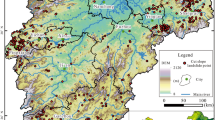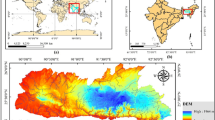Abstract
From June 10th to 13th, 2019, a continuous heavy rainfall occurred in Longchuan County, Guangdong Province, causing many landslide hazards. Among Longchuan County districts, Mibei Village is one of the hardest-hit areas and suffered severe losses. In this paper, field investigation, remote sensing image interpretation, and UAV aerial photography were used to investigate and analyze hazard characteristics. Combined with rainfall monitoring data, laboratory and field tests data, and existing research results, the characteristics and failure mechanism of group-occurring landslides in Mibei Village were studied. Because of the continuous heavy rainfall, 327 landslides occurred in the study area, mainly distributed in the north of the Mibei River and along the X158 road. The terrain slope of landslide hazards ranged from 35° to 45°, and the slope structure can be divided into two types. Granite residual soil was the main part of landslide mass, and sliding surface developed along with the interface between bedrock and covering layer. The continuous heavy rainfall from June 10th to 13th was the main triggering factor of the disaster. The total precipitation was 281.3 mm, and the rainfall on June 10th was 153.5 mm. The rain led to the continuous increase in volume water content in granite residual soil and completely weathered granite. The shear strength and parameters of the two materials changed differently, and slope stability continued to decrease, and then landslides occurred under terrain conditions and engineering excavation space. Untimely support and unreasonable support measures for the excavation slope exacerbated the disaster. The development degree of debris flows in the study area was very low, and debris flows were shown as the secondary disaster of landslides. The branch gully terrain is the key to transforming the landslide into the debris flow, and a large amount of loose deposits in the main gully will become the potential source of debris flow in the future.













Similar content being viewed by others
References
An R, Kong L, Li C, Luo X (2020) Damage characteristics of mechanics and microstructure of granite residual soil under hot and rainy weather Chinese. J Rock Mech Eng. https://doi.org/10.13722/j.cnki.jrme.2020.0073
Bhardwaj A, Wasson RJ, Ziegler AD, Chow WTL, Sundriyal YP (2019) Characteristics of rain-induced landslides in the Indian Himalaya: a case study of the Mandakini Catchment during the 2013 flood. Geomorphology 330:100–115. https://doi.org/10.1016/j.geomorph.2019.01.010
Chen H, Dadson S, Chi Y (2006) Recent rainfall-induced landslides and debris flow in northern Taiwan. Geomorphology 77:112–125. https://doi.org/10.1016/j.geomorph.2006.01.002
Chen W, Jian W, Dong Y, Lin X (2015) Influence of weak structural surface on stability of granite residual soil slopes the Chinese. J Geol Hazard Control 26:23–30. https://doi.org/10.16031/j.cnki.issn.1003-8035.2015.01.004
Crosta GB, Frattini P (2008) Rainfall-induced landslides and debris flows. Hydrol Process 22:473–477. https://doi.org/10.1002/hyp.6885
Fan L, Lehmann P, Zheng C, Or D (2020) Rainfall intensity temporal patterns affect shallow landslide triggering and hazard evolution. Geophys Res Lett. https://doi.org/10.1029/2019GL085994
Feng W, Hu Y, Xie J, Wang Q, Wu G (2016) Disaster mechanism and stability analysis of shattered bedding slopes triggered by rainfall—a case study of Sanxicun landslide Chinese. J Rock Mech Eng 35:2197–2207. https://doi.org/10.13722/j.cnki.jrme.2016.0420
Huang B et al (2019) Correlation between shear strength and soil physicochemical properties of different weathering profiles of the non-eroded and collapsing gully soils in Southern China. J Soil Sediment 19:3832–3846. https://doi.org/10.1007/s11368-019-02313-7
Jian W, Hu H, Luo Y, Tang W (2017) Experimental study on deterioration of granitic residual soil strength in wetting-drying cycles. J Eng Geol 25:592–597. https://doi.org/10.13544/j.cnki.jeg.2017.03.003
Jin G, Wang Y, Liu J, Xu J, Shen T (2019) Study on the contribution rate of slope aspects to landslides in Bailong River Basin. J Northwest Norm Univ (natural Science) 55:100–105. https://doi.org/10.16783/j.cnki.nwnuz.2019.05.017
Li Y, Ma C, Wang Y (2019) Landslides and debris flows caused by an extreme rainstorm on July 21 2012 in mountains near Beijing, China. Bull Eng Geol Environ 78:1265–1280. https://doi.org/10.1007/s10064-017-1187-0
Liu W, Song X, Luo J, Hu L (2020a) The processes and mechanisms of collapsing erosion for granite residual soil in southern China. J Soil Sediment 20:992–1002. https://doi.org/10.1007/s11368-019-02467-4
Liu W, Yang Z, He S (2020b) Modeling the landslide-generated debris flow from formation to propagation and run-out by considering the effect of vegetation. Landslides. https://doi.org/10.1007/s10346-020-01478-4
Marin RJ (2020) Physically based and distributed rainfall intensity and duration thresholds for shallow landslides. Landslides 17:2907–2917. https://doi.org/10.1007/s10346-020-01481-9
Netto ALC et al (2013) January 2011: the extreme landslide disaster in Brazil. Springer, Berlin, pp 377–384. https://doi.org/10.1007/978-3-642-31319-6_51
Sun Q, Yu M (2015) Analysis on precipitation variations of characteristics of Minxi zone in the recent 30 years. J Fujian Normal Univ (nat Sci Edition) 31:98–105
Wang L, Miao J, Han F (2018) Overview of impact of topography on precipitation in China over last 10 years. Meteorol Sci Technol 46:64–75. https://doi.org/10.19517/j.1671-6345.20170081
Wang M, Yan J, Li S (2014) Spatial-temporal variation and the tendency of droughts and floods on the southeast coast of China over 54 years. Resour Sci 36:2307–2315
Wang Z, Zhou Y, Li B, Tan B, Han X (2020) Micro-structure and evolution of relict joints and weathered granite soils in the southeastern Guangxi, China. J Earth Sci Environ 42:405–415. https://doi.org/10.19814/j.jese.2019.10040
Wei X, Fan W, Chai X, Cao Y, Nan Y (2020) Field and numerical investigations on triggering mechanism in typical rainfall-induced shallow landslides: a case study in the Ren River catchment, China. Nat Hazards 103:2145–2170. https://doi.org/10.1007/s11069-020-04075-9
Wei Y, Wu X, Xia J, Miller GA, Cai C, Guo Z, Hassanikhah A (2019) The effect of water content on the shear strength characteristics of granitic soils in South China. Soil Tillage Res 187:50–59. https://doi.org/10.1016/j.still.2018.11.013
Yang Z, Wang L, Qiao J, Uchimura T, Wang L (2020b) Application and verification of a multivariate real-time early warning method for rainfall-induced landslides: implication for evolution of landslide-generated debris flows. Landslides 17:2409–2419. https://doi.org/10.1007/s10346-020-01402-w
Yang H, Yang T, Zhang S, Zhao F, Hu K, Jiang Y (2020a) Rainfall-induced landslides and debris flows in Mengdong Town, Yunnan Province, China. Landslides 17:931–941. https://doi.org/10.1007/s10346-019-01336-y
Yi X, Feng W, Bai H, Shen H, Li H (2021) Catastrophic landslide triggered by persistent rainfall in Sichuan, China: August 21, 2020, Zhonghaicun landslide Landslides. https://doi.org/10.1007/s10346-021-01701-w
Zhang K, Wang S, Bao H, Zhao X (2019) Characteristics and influencing factors of rainfall-induced landslide and debris flow hazards in Shaanxi Province, China. Nat Hazard Earth Syst 19:93–105. https://doi.org/10.5194/nhess-19-93-2019
Acknowledgements
After the disaster, the State Council and the Ministry of Natural Resources issued essential instructions on the emergency rescue work in the stricken area. Governmental departments at all levels of Guangdong Province and Guangdong Volunteer Association actively and quickly rushed to the stricken area to carry out relevant rescue work, which significantly reduced the loss of life and property. In writing the paper, we received the support and help of many departments and individuals, which provided great convenience for developing the research work, and we would like to express our sincere thanks to them. We would like to thank the relevant departments of the Nonferrous Mine Geological Disaster Prevention Center of Guangdong Province for providing geological data and exploration reports, which help us to comprehensively grasp the study area's geological environment conditions. We are grateful to the people's Government, the Meteorological Bureau, Natural Resources Bureau of Longchuan County to provide us with important rainfall data at different stages and help us carry out fieldwork, which has extensively promoted the research work. At the same time, we are here to express our gratitude to all the Mibei Village residents for helping us understand the specific situation of the disaster and assist the research group in completing part of the field tests. We wish them a better life as soon as possible. Besides, we would like to thank Google Earth and geological cloud site ( http://geocloud.cgs.gov.cn/ ) for providing remote sensing datum.
Funding
This research is financially supported by The National Natural Science Foundation of China (Grant No. 41977252, U2005205), The Team Project of Independent Research of SKLGP (Grant No. SKLGP2016Z001), Opening Foundation of Key Laboratory of Geohazard Prevention of Hilly Mountains, Ministry of Natural Resources (Fujian Key Laboratory Of Geohazard Prevention) (Grant No. FJKLGH2021K006), The Research Project of Nonferrous Mine Geological Disaster Prevention Center of Guangdong Province.
Author information
Authors and Affiliations
Corresponding author
Ethics declarations
Conflict of interest
The authors declare that they have no conflict of interest.
Additional information
Publisher's Note
Springer Nature remains neutral with regard to jurisdictional claims in published maps and institutional affiliations.
Rights and permissions
About this article
Cite this article
Bai, H., Feng, W., Yi, X. et al. Group-occurring landslides and debris flows caused by the continuous heavy rainfall in June 2019 in Mibei Village, Longchuan County, Guangdong Province, China. Nat Hazards 108, 3181–3201 (2021). https://doi.org/10.1007/s11069-021-04819-1
Received:
Accepted:
Published:
Issue Date:
DOI: https://doi.org/10.1007/s11069-021-04819-1




